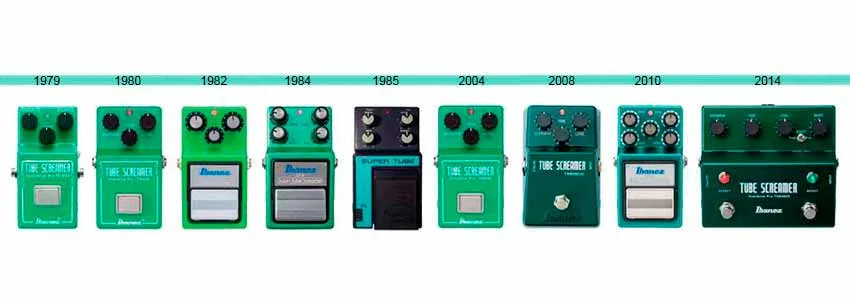Blog, Effect Pedal History
History of the TubeScreamer TS808 Overdrive Effect Pedal
Like many people starting playing the guitar, we first used small sized combo amps with their own integrated distortion circuit, and as beginners we weren’t aware of the existence of effect pedals.
The first time we heard the Tubescreamer overdrive effect pedal was on Andy Timmon’s Electric Gipsy, and we were amazed about the tone. Opposed to heavy metal distortions we were used to hear and get from our small transistor amp, this was a warm and pleasant overdrive.
This is how we discovered this effect pedal (and fell in love with it!). The TubeScreamer was our first attempt to build a pedal, and when playing and looking for a distortion, it’s always our first choice. Keep reading if you also like this overdrive, and build your own Tubescreamer TS808!!
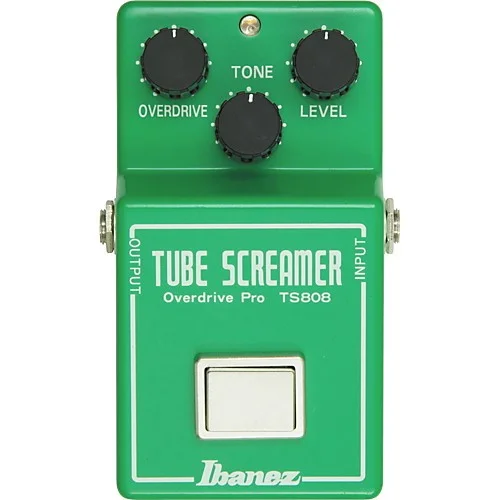
A BIT OF BACKGROUND ABOUT THE TUBESCREAMER OVERDRIVE
The TubeScreamer is an overdrive effect pedal produced by Ibanez. Its name comes from the fact that it sounds like an overdriven tube amp, an overdrive a lot warmer and mellow than the distortion you’ll get from a silicon transistor. The TubeScreamer’s circuit boosts the mid frequencies giving more “punch” to the sound, and has become one of the most used overdrive effect pedals ever.
Listen to Stevie Ray Vaughan and you’ll get a pretty good idea of the tones you can get out of it!
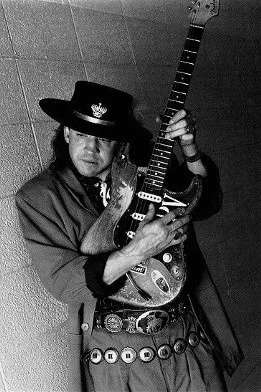
The first TubeScreamer version was the TS808 and came out in the late ’70. It was popularized by Stevie Ray Vaughan among others. The distinctive TubeScreamer sound is due to its symmetrical distortion, which means that the signal is cut in the same way in the positive and negative cycles (we’ll get into detail in the next section!).
When the TubeScreamer came out other manufacturers as Roland were producing their own distortion pedals as the Boss Overdrive, and they had patents on asymmetrical clipping (the one that happens naturally in tube amps). Because of that, S. Tamura, the father of the TubeScreamer, had to look for a symmetrical clipping circuit. Besides, the TubeScreamer was the first effect pedal circuit built around an integrated circuit (the dual operational amplifier JRC4558, made by Japan Radio Company, that become a cult IC for every TubeScreamer lover): until then, circuits were built around transistors. The pedal had a Volume, Drive and Tone controls.
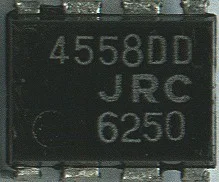
After this first version there’s been a huge amount of TubeScreamer reissues (TS9, TS10, TS7, TS5…). They are all built around the same circuit with some small differences, but none of them had the impact the original TubeScreamer had. Because of that, there’s a “myth” or cult around the parts used in the original TS808, particularly around the dual opamp JRC4558. This integrated circuit has been substituted in the newer versions of the TubeScreamer, and it’s a hard part to find nowadays.
From all the ICs used in the different versions, the JRC4558 is the one that delivers the warmest overdrive according to most TubeScreamer users, but as always, it’s a good idea substituting and trying different dual opamps that have the same pinout (TL072, LM386…) and hear which sound we like the most.
THE TUBESCREAMER OVERDRIVE CIRCUIT
For all of you enthusiastic about electronics we’ll explain with a bit more detail how the TubeScreamer circuit works, analyzing each stage individually. If you’re not into electronics, you can skip this section!
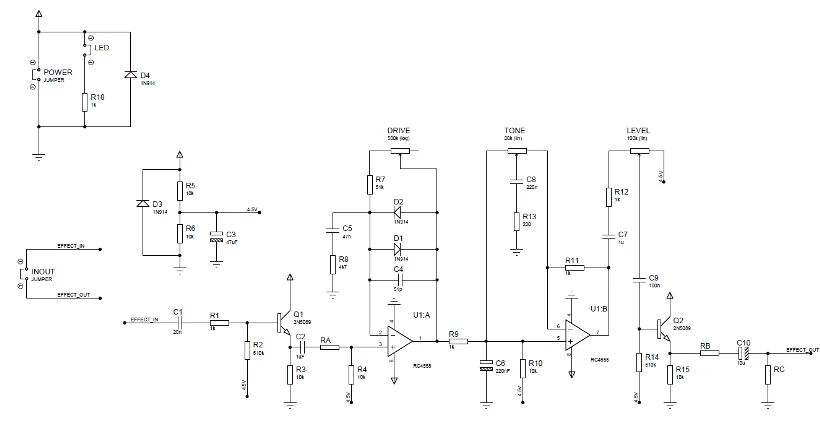
The different TubeScreamer versions share a common circuit with minor differences, and a single schematic covers them all. In the end of this section we’ll detail which are these differences.
1 – Input Buffer
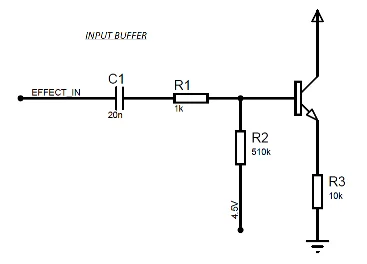
The first stage is an input buffer. It’s nothing but a transistor in an emitter follower configuration, which provides unity gain and a high input impedance to avoid loading too much the guitar pickups.
2 – Clipping Stage
The output of the input buffer goes straight into the clipping stage (here’s where the magic happens!). Simplifying the circuit and not taking into account the capacitors and diodes, this is a non inverting amplifier, with a gain set by the Drivepotentiometer.
When we add the capacitor C5 and the resistor R8, we get a circuit that is frequency-selective, which means that not every frequency in the sound will be equally amplified. Specifically, the combination of R8 and C5 is a 720Hz high pass filter. In DC, the capacitor C5 acts like an open circuit; if we remove the branch from the (-) pin of the opamp to ground we have a voltage follower with a unity gain, so low frequencies won’t be amplified (and won’t have any kind of clipping or distortion).
In AC, the capacitor C4 acts like a short circuit, turning the circuit into a voltage follower with unity gain: very high frequencies won’t get any boost either. Putting it together, the TubeScreamer is a circuit that will only amplify the medium frequencies.
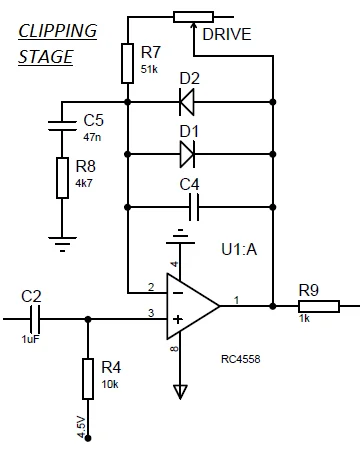
So far we’ve seen how the TubeScreamer reacts like an amplifier but… Why does it have this distinctive warm sound? Here’s where the clipping diodes come into play. They have a similar job than the capacitors, but instead of filtering by frequency they “filter” by signal volume: while it stays under the diode’s forward voltage (~0.6V for silicon diodes) they act like an open circuit, so we have a non inverting amplifier. But as soon as the signal is greater than 0.6V, the diode turns on and acts like a short circuit, making the circuit a voltage follower with unity gain: every signal above 0.6V won’t get amplified. The signal is then “cut” or clipped, as you can see in the next picture. Having two diodes, one on each direction, makes the clipping symmetrical.
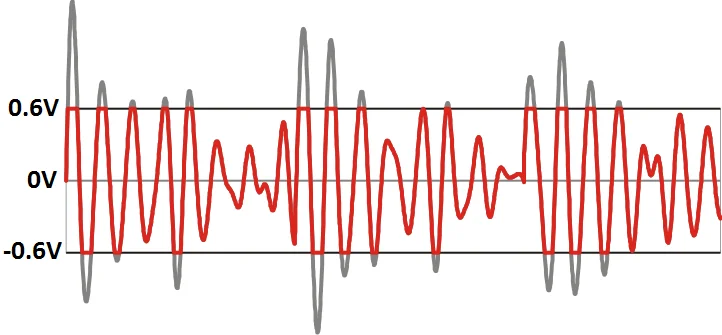
Other overdrive effect pedals and some TubeScreamer mods use different diodes (for example, a silicon with forward voltage Vd = 0.6V and a germanium one with Vd = 0.3V) to get an asymmetrical clipping. This drastically changes the sound of the pedal, and is an easy mod you can perform on your pedal to get the most of it.
Summing all up, the TubeScreamer is an amplifier that will perform a symmetrical signal clipping, boosting mid frequencies.
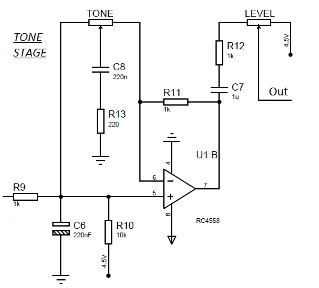
3 – Tone and Volume
After this stage, we get finally in the last one,Tone and Volume, through a resistor-capacitor set. This is a low pass filter of around 720Hz that removes higher frequency harmonics to get a much softer and warmer tone. The filtering is done with the “Tone” potentiometer with C8 and R13. After that, we set the output volume with the “Level” potentiometer.
DIFFERENT TUBESCREAMER OVERDRIVE VERSIONS
Since its first appearance there’s been many different TubeScreamer versions. Some of them are the TS9, the TS10 and the TS808. These versions are only different in the values of three resistors and in the IC they use. In this chart you can find the different values:
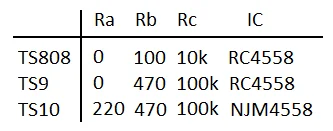
HOW DOES THE TUBESCREAMER SOUND LIKE?
It’s important to be aware of the fact that the TubeScreamer is an overdrive effect pedal. If you’re looking for some powerful distortions for metal, the TubeScreamer clearly isn’t your pedal. But if you’d rather get a versatile effect that suits everything from blues to rock, the TubeScreamer will be one of your favorites!
Do you want to build your own TubeScreamer TS808? Our TubeScreamer kit includes everything you need to build your own overdrive effect pedal!
Here’s a demo video of the TubeScreamer we recorded some time ago. We hope you liked this post, see you on the next one!

